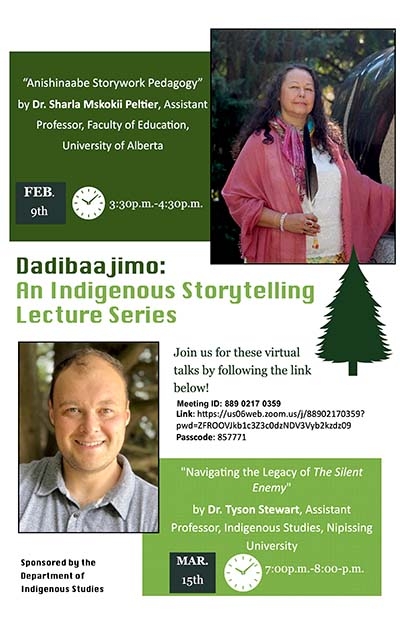Navigating the Legacy of The Silent Enemy

by Tyson Stewart
Dadibaajimo: An Indigenous Storytelling Lecture Series
Paramount Pictures’ The Silent Enemy, released in 1930, is a fascinating cultural artefact made and released during the transition from silent to sound film. One of the last silent feature films made by the studio, this critically acclaimed film took three years to make and was shot in large part on location on n’Daki Menan, the traditional territory of the Teme Augama Anishnabai in Northern Ontario. Like other silent films made in Indigenous communities during this period such as Curtis’ In the Land of the Head Hunters (1914) and Myles’ The Daughter of Dawn (1920), The Silent Enemy employed local Indigenous actors and drew on their knowledge and traditions to construct its vision of pre-contact Anishinaabe life. While the exact location and community are never mentioned or acknowledged in The Silent Enemy itself, local Anishinaabe people were hired to act in the film and make the costumes and sets, all elements of film form that added greatly to the production’s claims of authenticity. What were the Teme Augama Anishnabai doing at the time of the production? And how do they reconcile their traditional on-the-land lifestyles, including the use of family hunting grounds, and the portrayals of nomadic tribal lives in the film? While the film recycles the prominent ethnographic narrative of the dying “Indian” culture, it does feature ironic moments of Indigenous survivance, such as an introductory sequence with Chief Yellow Robe shot in synchronized sound, naturalistic performances and mise-en-scène by locals that continue to captivate community members, and over-the-top colonial takes on pre-contact life. I trace the afterlife of this settler-colonial silent feature in light of star Chief Long Lance’s “outing” as an African-American, its failure at the box-office just as sound was taking over, and its long-lasting influence as both a personal and public historical artefact for the Teme Augama Anishnabai.
INDG is inviting you to a scheduled Zoom meeting.
Topic: Dadibaajimo Lecture Series
Time: This is a recurring meeting Meet anytime
Join Zoom Meeting
https://us06web.zoom.us/j/88902170359?pwd=ZFROOVJkb1c3Z3c0dzNDV3Vyb2kzd…
Meeting ID: 889 0217 0359
Passcode: 857771
One tap mobile
+19292056099,,88902170359#,,,,*857771# US (New York)
+12532158782,,88902170359#,,,,*857771# US (Tacoma)
Dial by your location
+1 929 205 6099 US (New York)
+1 253 215 8782 US (Tacoma)
+1 301 715 8592 US (Washington DC)
+1 312 626 6799 US (Chicago)
+1 346 248 7799 US (Houston)
+1 669 900 6833 US (San Jose)
Meeting ID: 889 0217 0359
Passcode: 857771
Find your local number: https://us06web.zoom.us/u/kbh4WjRaIl
